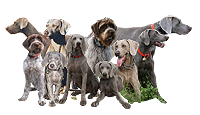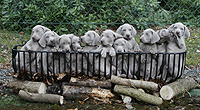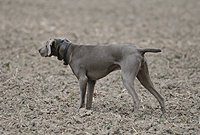HEAD :
Skull
In harmony with the body size and the foreface. Broader in dogs than in bitches, however, in both sexes, the relative broadness of the skull should be in proportion to the total length of the head. A median line extending back over the forehead. A slight to moderately prominent occiput. Zygomatic arches easily traceable behind the eyes. Very moderate stop.
Foreface:
Nose: Surface area large, protruding over the lower jaw. Dark flesh coloured, gradually changing to grey towards the rear.
Muzzle: Long and, especially in the male, powerful, in profile almost appearing angular. Canine and molar regions of the jaw about equally strong. Bridge of muzzle is straight, often slightly arched, but never dish faced.
Lips: Moderately deep and pinkish, flesh-coloured, the same as the palate. Small mouth fold.
Jaw: Powerful.
Bite: Complete, regular and strong dentition. Incisors should touch with a correct scissor bite.
Cheeks: Muscular and clearly defined. "Dry" head (skin tightly drawn).
Eyes : Amber coloured, from dark to light, and of intelligent expression. Round, only slightly obliquely set. Skyblue in puppies. Eyelids well fitting.
Ears : Broad and rather long, should reach approximately the corner of the mouth; rounded at the tips; set on high and narrow; folded; when attentive turned slightly forward.
NECK
Noble appearance and carriage, upper profile is slightly arched. Muscular, almost round, not too short. Dry. Strengthening towards the shoulders, and flowing harmoniously into the backline and chest.
BODY
Topline: Flowing harmoniously from the arched neckline to the well defined withers into the relatively long, firm back.
Withers: Well defined.
Back: Strong and muscular; not sway backed; not overbuilt behind. A slightly long back is a breed characteristic and not faulty.
Croup: Pelvis long and moderately sloped.
Chest: Strong, not excessively broad with sufficient depth and length, descending almost to the elbow. Ribs long, well-sprung but not barrel-shaped. Forechest well developed.
Underline: Sweeping up slightly, however, belly not tucked up.
TAIL
The tailset is a little lower under the topline than in other comparable breeds. Tail strong and well covered with hair, hanging down when relaxed. Carried horizontally or somewhat higher when at attention or when working.
MEMBRES :
Forequarters
Front legs - General: Legs "high", sinewy, straight and parallel, but not standing too far apart.
Upper Arm: Set at an angle with sufficient length and strength.
Elbows: Lying free and straight. Turning neither in nor out.
Forearm: Long and straight.
Pastern (Metacarpus): Sinewy, slightly sloped.
Shoulders: Well angulated, long and well fitting, strongly muscled. Good angulation of the shoulder blade and upper arm joint.
Feet Front : Compact and strong. Standing straight in relation to the median plane of the body. Toes arched. Longer middle toes are a breed characteristic and therefore not faulty. Nails light to dark grey. Pads well pigmented and tough.
Hindquarters
General: High on leg, sinewy or well muscled. Stands parallel, turning neither in nor out.
Upper Thigh: Sufficiently long, strong and well muscled.
Stifle: Strong and taut.
Lower Thigh: Long, tendons clearly visible.
Hock: Strong and taut.
Rear Pastern: Sinewy, almost vertical when standing.
Feet Hind : Compact and strong, without dewclaws; otherwise as for front feet.
GAIT / MOVEMENT
Movement at every pace is ground covering and flowing. Hind and fore legs are placed parallel. The gallop-stride is long and low. During the trot, the back remains level. Pacing is undesirable
SKIN
Strong. Well fitting, but not too tight.
COAT :
Short-haired : Short, (but longer and more dense than in most comparable breeds), strong, very dense, sleek topcoat. Without, or with very little undercoat.
Long-haired : Soft, long topcoat, with or without undercoat. Smooth or slightly wavy. Hair at base of ear long and flowing. On the ear tips velvety hair is permissible. Hair length on the sides 3-5 cm (11/2- 2 ins), usually a little longer on the underside of neck, the forechest and on the belly. Good feathering and breeching, however the hair is shorter towards the lower parts. Tail with good flag. Hair between toes. Shorter hair on head. Double Coat (Stockhaar), with medium long, dense and well fitting topcoat, thick, woolly undercoat and moderate feathering and breeching occasionally occurs in heterozygotic (of mixed coat type ancestry) dogs.
Color
Silver-, roe deer- or mouse-grey, as well as shadings between these colour tones. Head and ears usually a little lighter. Small white markings are only permissible on the chest and toes. Occasionally, along the middle of the back, a more or less well defined "eel stripe" may be seen.
Dogs with distinctly red-yellow "markings" may be awarded no higher than the grading of "Good" in conformation. Brown markings are a serious fault.
SIZE
Height at Withers
Dogs : 59 to70 cm, best size from 62 to 67 cm.
Bitches : 57 to 65 cm, best size from 59 to 63 cm.
Weight :
Dogs : from 30 to 40 kg.
Bitches : from 25 to 35 kg.
NOTE - Male animals must have two apparently normally developed testicles fully descended into the scrotum.
FAULTS
Any departure from the foregoing points should be considered a fault and the seriousness with which the fault should be regarded should be in exact proportion to its degree.
MAJOR FAULTS
General Appearance:
Distinct deviation of type. Untypical sexual characteristics.
Serious deviations from the correct proportions.
Temperament: Slight character defects.
Head and Skull: Skull: Serious deviations in size and proportions.
Foreface: Serious deviations, such as lips too thick; short or snipy muzzle.
Eyes: Slight lid defects, especially when also one-sided.
Ears: Decidedly short or long, not turned forward.
Mouth: Missing more than two P1's or one M3.
Neck: Dewlap. Great deviation in shape and musculature of neck.
Forequarters: Very incorrect stance, such as lacking angulation, out at elbow, splay feet.
Body: Back: Distinctly dipped or roached. Loins higher than withers.
Chest, Belly: Barrel-shaped chest; insufficient depth or length of chest. Tucked-up belly.
Hindquarters: Severely bow-legged or cow hocked.
Feet: Open feet.
Gait/Movement: Poor movement in any particular gait; lacking reach and drive; pacing.
Coat: Serious defects, such as very thin or very coarse.
Blending of the coat varieties defined in the Standard.
Lacking hair on belly or ears (ear leathers), patches of woolly hair in the Shorthair. Very curly or sparse in the Longhair.
Colour: Deviations of grey tones such as yellowish or brownish.
Brown markings.
Size: Great deviations in size and weight, such as more than 2 cm (4/5th ins) in stick measure.
Further: Other serious defects.
Sexual Organs: Distinct deviations of the testicles in shape, size or consistency.
* The list of Serious Faults can naturally not cover all faults that occur; it is to be taken as an example.
DISQUALIFYING FAULTS
General Appearance: Absolutely untypical, especially too heavy or too light in build. Completely out of proportion.
Temperament: Character defects such as shy or nervous.
Head and Skull: Skull: absolutely untypical, such as Bulldog-like.
Foreface: Absolutely untypical, such as dish-faced.
Eyes: Entropion, ectropion.
Ears: Absolutely untypical, such as standing off.
Mouth: Overshot; undershot; missing further teeth other than quoted.
Neck: Very pronounced dewlap.
Forequarters: Rickety or deformed legs.
Body: Back: Extremely dipped or roached. Loins considerably higher than withers.
Chest, belly: Chest decidedly barrel-shaped or mis-shapen.
Hindquarters: Hip Dysplasia.
Gait/Movement: Movement totally restricted and unsound.
Coat: Skin malformations and defects. Part or total hairlessness.
Colour: Colour other than grey. Widespread brown markings.
White markings except on chest and feet.
Size: Extremely over- or undersize.
Further: Other malformations. Diseases which must be presumed to be hereditary, such as epilepsy.
Sexual Organs: Monorchidism; cryptorchidism. |
 Photos et Infos sur nos chiens
Photos et Infos sur nos chiens
 Les étalons proposés pour la reproductions / The studs for reproduction
Les étalons proposés pour la reproductions / The studs for reproduction